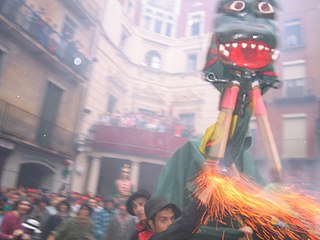Related Research Articles
In Māori mythology, taniwha are large supernatural beings that live in deep pools in rivers, dark caves, or in the sea, especially in places with dangerous currents or deceptive breakers . They may be considered highly respected kaitiaki of people and places, or in some traditions as dangerous, predatory beings, which for example would kidnap women to have as wives.

Ayida-Weddo, also known as Ayida, Ayida-Wedo, Aido Quedo, Aido Wedo, Aida Wedo, and Aido Hwedo, is a powerful loa spirit in Vodou, revered in regions across Africa and the Caribbean, namely in Benin and Haiti. Known as the "Rainbow Serpent", Ayida-Weddo is the loa of fertility, rainbows, wind, water, fire, wealth, thunder, and snakes. Alongside Damballa, Ayida-Weddo is regarded among the most ancient and significant loa. Considered in many sources as the female half of Damballa's twin spirit, the names Da Ayida Hwedo, Dan Ayida Hwedo, and Dan Aida Wedo have also been used to refer to her. Thought to have existed before the Earth, Ayida-Weddo assisted the creator goddess Mawu-Lisa in the formation of the world, and is responsible for holding together the Earth and heavens. Ayida-Weddo bestows love and well-being upon her followers, teaching fluidity and the connection between body and spirit.
In Inuit folklore, the kăk-whăn’-û-ghăt kǐg-û-lu’-nǐk or akh’lut is an orca-like composite animal that takes the form of a wolf when on land, and is sometimes depicted as a wolf-orca hybrid.
Apalāla is a water-dwelling Nāga in Buddhist mythology. It is said that Apalāla lived near the Swat River, this area is currently located in Peshawar, Khyber-Pakhtunkhwa Province, Pakistan. He is known to be a Naga King.

An ogre is a legendary monster depicted as a large, hideous, man-like being that eats ordinary human beings, especially infants and children. Ogres frequently feature in mythology, folklore, and fiction throughout the world. They appear in many classic works of literature, and are most often associated in fairy tales and legend.

In South Jersey and Philadelphia folklore in the United States, the Jersey Devil, also known as the Leeds Devil, is a legendary creature said to inhabit the forests of the Pine Barrens in South Jersey. The creature is often described as a flying biped with hooves, but there are many variations. The common description is that of a bipedal kangaroo-like or wyvern-like creature with a horse- or goat-like head, leathery bat-like wings, horns, small arms with clawed hands, legs with cloven hooves, and a forked or pointed tail. It is also said that it has a strange elongated body and a thick tail. It has been reported to move quickly and is often described as emitting a high-pitched "blood-curdling scream".
Chamrosh is a bird in Persian mythology said to live on the summit of Mount Alborz.

In Slavic mythology, vodyanoy is a water spirit. In Czech and Slovak fairy tales, it is called vodník, and it is considered to be the equivalent creature as the Wassermann or nix of German fairy tales. In Ukrainian fairy tales, it is called “водяник“ (vodyanyk).

Amphiptere is a type of winged serpent found in European heraldry.
The splintercat is a legendary fearsome critter in the folklore of the United States.

In American folklore, the axehandle hound is a fearsome critter of Minnesota and Wisconsin.
Abere is a demoness from Melanesian mythology. She is portrayed as a "wild" woman with young female servants. She is said to reside in marshes. She draws people to her by her beauty, entrapping them by causing reeds to grow around them. Once they are trapped, she proceeds to devour her victims.
Abaia is a huge, magical eel in Melanesian mythology.

La Guita Xica is a dragon that appears amongst the legends of Catalonia beginning in 1890. The dragon had many names, including Guita Boja, La Guita Xica, Mulaguita, La Mulassa, Mula Fera, and Mula Guita. Its name transformed over time, originally started as Mulassa, then Mulaguita, and finally Guita by the twentieth century. The name La Mulassa comes from an older term, mulassas, meaning 'monstrous mules,' which was used in Catalan mythology to refer to mule-dragon hybrids. La Guita Xica was originally considered a demon, but has become a protective spirit over the past century. It is also called a tarasca, which is a name for draconic creatures of Spanish and Latin American folklore.

The Grootslang or Grote Slang is a legendary creature that is reputed to dwell in a deep cave in the Richtersveld, South Africa.
The Apotamkin is a creature in Native American mythology. According to the mythology, it is a giant fanged sea monster that lives in the Passamaquoddy Bay and pulls people in to eat them, particularly careless children. It is said to have long red hair, and in some versions, it was a human woman before being changed into a serpent. One interpretation of Apotamkin myth is that it was used to instill fear into children to keep them from venturing into areas alone and without parental guidance.

Giants, Monsters & Dragons: An Encyclopedia of Folklore, Legend and Myth is an encyclopedia of monsters, folklore, myths, and legends compiled by Carol Rose. The book features small entries about monsters, folklore, myths and legends from around the world, and includes many illustrations.

The Sin-you is a mythical creature known throughout various East Asian cultures.
The Aeternae were a race of legendary creatures described in the travels of Alexander the Great. As Alexander's army passed northern Indian plains, they supposedly encountered the Aeternae, who killed some of Alexander's men. The Aeternae were described as killing and wounding enemies with "bony, saw-toothed protuberances sprouting from their heads."
References
- 1 2 Carol Rose, Giants, Monsters, and Dragons: An Encyclopedia of Folklore, Legend, and Myth, ABC-CLIO, Inc., Santa Barbara, California, 2000, 229, https://archive.org/details/giantsmonstersdr0000rose/page/228.